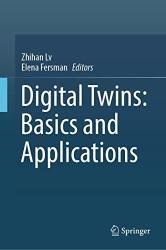 Название: Digital Twins: Basics and Applications
Название: Digital Twins: Basics and ApplicationsАвтор: Zhihan Lv, Elena Fersman
Издательство: Springer
Год: 2022
Страниц: 102
Язык: английский
Формат: pdf (true), epub
Размер: 20.1 MB
This book comprehensively introduces readers to Digital Twins, from the basic concepts, core technologies and technical architecture, to application scenarios and other aspects. Readers will gain a profound understanding of the emerging discipline of Digital Twins. Covering the latest and cutting-edge application technologies of Digital Twins in various fields, the book offers practitioners concrete problem-solving strategies. At the same time, it helps those working in Digital Twins-related fields to deepen their understanding of the industry and enhance their professional knowledge and skills. Given its scope, the book can also be used as teaching material or a reference book for teachers and students of product design, industrial design, design management, design marketing and related disciplines at colleges and universities. Covering a variety of groundbreaking Digital Twins technologies, it can also provide new directions for researchers.
The Chapter 1 presents an overview of the Digital Twin (DT) building architecture. In general, we can understand the DT as a decision support system composed of four main components: (i) Physical system, (ii) virtual system, (iii) systems data, and (iv) communication interface. The physical system is composed of people, machines, and processes and represents the main focus of DT. On the other hand, the virtual system is composed of one or more highly synchronized virtual models, which are capable of mirroring physical behaviors and, through analysis tools and techniques, provides optimized decisions. Systems data correspond to both physical and virtual data. The virtual model mirrors the physical through its data, that is, information collected over time, while the virtual model returns information to the physical systems through actions and decision guidelines. Finally, we highlight the communication interface as a link that allows the integration between physical and virtual environments. In this case, the entire structure that allows the exchange of data and communication between the systems has a fundamental role regarding the DT's correct functioning. In this chapter, the reader will comprehensively understand the role and the main characteristics of each DT component and subcomponent. From an approach focused on conceptualization followed by practical examples, the advantages and limitations associated with current DT practices are highlighted, providing a solid basis on the main DT architectures for practitioners and researchers.
The Virtual System (VS) is probably the most important component of DT considering visual characteristics. Usually, the VS may be described as a DT synonym, but we already know that this statement is wrong since there are other components necessary for the design of a DT. In this case, we can simplify the VS as a set of all the computational resources used to virtually represent the behavior of the PS over time. Firstly, we highlight the widely used and well-known commercial packages, which include softwares such as CATIA, SolidWorks, and AutoCAD for visual representation and FlexSim, Tecnomatrix, AnyLogic, Simio, Arena, 3DVIA Composer, and Unity 3D for behavioral representation. In addition, there is a significant portion of virtual models that are based on proprietary codes and computer programs, developed especially for a given application.
Once the role of the other DT’s components was understood, the importance of the fourth and final component, the Communication Interface (CI), becomes clear. Considering that the physical and virtual environments are already implemented and the data of the systems are available, the CI allows the collection, integration, and exchange of data and information between both environments, allowing the DT operation over time. Therefore, we describe the CI as every structure (hardware and software) that allows such integration. In the same way as the other components, the Industry 4.0 has been revolutionizing the structure that composes the CI. In this case, in addition to the well-known information technology (IT), we highlight solutions such as: (i) Internet of things (IoT), which enable the connection of multiple processes, machines, products, and equipment; (ii) Big Data, focused on solutions that allow data processing on a large scale and variety; and (iii) cloud technology, based on developments focused on data flows without the need for physical resources.
Furthermore, it is important to highlight that the processing and transmission of data and information between the physical and virtual environments directly impact the validity of the DTs’ results. In this context, several communication protocols can be used to allow the sharing of information between different DT elements. Among the main protocols, we highlight: DT Definition Language (DTDL); FIWARE; Open Platform Communication Unified Architecture (OPC UA); Feature-Based DT Framework (FDTF); Constrained Application Protocol (CoAP); Message Queuing Telemetry Transport (MQTT); Modbus Transmission Control Protocol (TCP/IP); and Ultra Reliable Low Latency Communication (URLLC).
Скачать Digital Twins: Basics and Applications